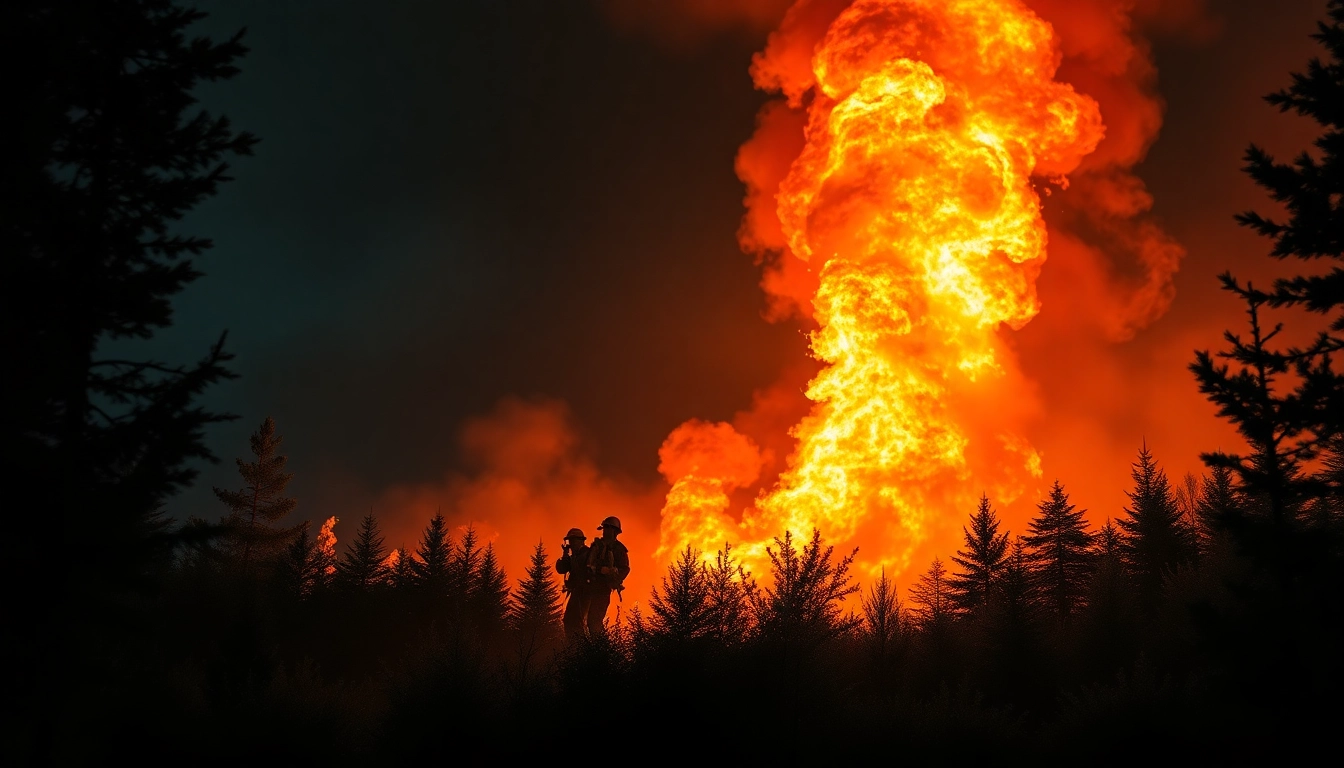Understanding Wildfire Events: Strategies, Impacts, and Safety Measures
Introduction to Wildfire Events
Wildfires have become a pressing concern in today’s natural landscape, dramatically impacting ecosystems, communities, and even economies. Understanding wildfire events, including their causes and consequences, is essential for developing effective management and prevention strategies. This comprehensive guide explores all aspects of wildfire events, elevating awareness and preparedness for those affected. For those keen on knowing more about wildfire events, this article offers valuable insights into the complexity of these phenomena.
Definition and Types of Wildfire Events
A wildfire, also known as a forest fire, bushfire, or grass fire, is an uncontrolled fire that burns in wildland or area with combustible vegetation. Wildfires can be classified into several types, each with distinct characteristics:
- Surface Fires: These are the most common wildfires, burning surface litter and underbrush while remaining low to the ground. They are typically easier to manage than other types.
- Crown Fires: These fires burn through the tops of trees, spreading rapidly through the canopy. They are often influenced by wind conditions and are substantially harder to control.
- Ground Fires: These burn underneath the soil surface, typically in peat or other organic material, making them difficult to detect and control.
Understanding these types is crucial because they vary widely in behavior, intensity, and method of management. Fire management strategies must be tailored to the specific kind of wildfire encountered in a given scenario.
The Importance of Awareness during Wildfire Events
Awareness is pivotal during wildfire events. By enhancing individual and community understanding of fire risks, preparedness measures can be significantly improved. Awareness programs educate populations about the proper steps for prevention, safety protocols, and evacuation plans. This education can be the difference between life and death, especially in regions prone to wildfires.
Moreover, awareness campaigns can assist in building resilient communities. Engaging local governments, organizations, and individuals allows for coordinated responses to potential wildfire threats while fostering a culture of preparedness.
Key Statistics on Wildfire Events in Recent Years
Recent years have witnessed an alarming increase in wildfire incidents worldwide, with significant economic and ecological impacts. According to the National Interagency Fire Center (NIFC), there were approximately 58,000 wildfires across the United States in 2020, consuming over 10 million acres of land. This trend reflects not only natural occurrences but also human-induced factors exacerbated by climate change and poor land management practices.
In the context of global statistics, regions like Australia and California reported staggering losses, further emphasizing the critical need for proactive wildfire management. Understanding these figures is vital for policymakers and communities alike, as they highlight the increasing severity of these events and the resources required for effective responses.
Causes and Risk Factors of Wildfire Events
Natural vs. Human-Induced Wildfire Events
Wildfires can be ignited by natural causes, such as lightning strikes or volcanic eruptions, but human activities account for a significant portion of wildfire incidents. According to the U.S. Forest Service, approximately 85% of wildfires in the United States are caused by human activities, including campfires left unattended, discarded cigarettes, and power lines. Recognizing these causes is crucial for designing effective prevention strategies.
Climate Change and Its Impact on Wildfire Events
Climate change has emerged as a powerful driver of increasing wildfire incidences globally. Rising temperatures, shifting precipitation patterns, and prolonged droughts create an environment conducive to wildfires. The changing climate results in more frequent and intense fires, significantly lengthening wildfire seasons. For example, studies have shown that in the Western United States, the fire season has expanded by nearly 80 days since the 1970s. This escalation calls for adaptive fire management strategies capable of responding to this new reality.
Geographic Regions Most Affected by Wildfire Events
Certain geographic areas are more prone to wildfires due to their climates, vegetation types, and human activities. For instance:
- Western United States: California, Oregon, and Washington frequently experience significant wildfire events, leading to devastating consequences for air quality and natural habitats.
- Australia: Known for its bushfires, Australia faces extreme fire weather conditions, particularly during summer months.
- Southern Europe: Countries like Portugal and Greece endure summer wildfires, often exacerbated by prolonged drought conditions.
These regions necessitate distinct fire management strategies that align with local conditions, risks, and climate projections.
Fire Management Strategies for Wildfire Events
Preventive Measures Against Wildfire Events
Preventive measures play a foundational role in reducing the incidence of wildfires. Effective strategies include:
- Community Education: Local fire authorities should implement educational programs aimed at teaching residents about fire risks and safety precautions.
- Controlled Burns: This practice involves intentionally setting controlled fires to reduce excessive vegetation, thus minimizing fuel for potential wildfires.
- Wildfire Risk Assessments: Regular assessments help identify high-risk areas and aid in developing targeted mitigation strategies.
Firefighting Techniques and Technologies
As wildfires grow in frequency and intensity, firefighting techniques must also evolve. Contemporary firefighting approaches include:
- Aerial Firefighting: Utilizing aircraft to drop water and fire retardants on burning areas enhances resource efficiency.
- Fire Suppression Tools: Modern equipment such as portable pumps and thermal imaging cameras aids in swiftly locating hotspots and managing fire lines.
- Remote Sensing Technology: Drones and satellite imagery are increasingly used to monitor large areas for active fire events and evaluate previous fire effects.
Incorporating innovative technologies not only boosts firefighting efficiency but also improves safety measures for personnel on the ground.
Community Involvement in Wildfire Events Management
Community involvement is essential in wildfire management and prevention. Engaging local residents enhances support for wildfire policies, fosters preparedness, and strengthens community bonds. Key strategies for community involvement include:
- Community Fire Plans: Collaboratively developed evacuation and safety plans empower communities to respond effectively to wildfires.
- Volunteer Firefighting Teams: Training individuals to serve as volunteer firefighters can provide crucial support during active incidents.
- Neighborhood Watch Programs: Encouraging vigilance among residents can lead to faster reporting of fire anomalies, ultimately aiding in quicker response times.
Impacts of Wildfire Events on Environment and Communities
Ecological Consequences of Wildfire Events
Wildfires can have immediate and long-term ecological effects. While some ecosystems require fire for renewal, the damage can lead to significant degradation, including:
- Loss of Biodiversity: Wildfires often wipe out entire habitats, adversely affecting local flora and fauna.
- Soil Erosion: The vegetation cover is essential for soil stability; when destroyed, increased erosion can occur, leading to further ecological harm.
- Air and Water Quality: Smoke from wildfires can significantly degrade air quality, while runoff from fire-affected areas can contaminate water bodies.
Social & Economic Impacts of Wildfire Events
Beyond environmental considerations, wildfires also pose substantial social and economic challenges. These include:
- Displacement of Communities: Wildfires can lead to mass evacuations and displacements, resulting in severe emotional and financial repercussions for families.
- Economic Losses: Wildfire-related damages can cost billions of dollars in property, emergency services, and loss of productivity.
- Impact on Tourism: Regions affected by wildfires often see a decline in tourism, further crippling local economies dependent on this revenue.
Health Risks Associated with Wildfire Events
The health risks from wildfires extend beyond physical injuries sustained during fire incidents. They include:
- Respiratory Issues: Health professionals have reported spikes in respiratory problems and cardiovascular issues during wildfire events due to smoke and particulate matter.
- Mental Health Concerns: The stress associated with evacuation, loss of property, and uncertainty can lead to significant mental health challenges, including anxiety and depression.
- Impact on Vulnerable Populations: Elderly and those with pre-existing health conditions are at a heightened risk during wildfire events, necessitating targeted interventions to protect them.
Preparing for and Responding to Wildfire Events
Emergency Preparedness Plans for Residents
Emergency preparedness is critical for residents living in wildfire-prone areas. Implementing a well-structured emergency plan can save lives and property, including:
- Creating an Evacuation Plan: Design specified escape routes and communicate them clearly to all family members.
- Emergency Kits: Stock up on essential supplies, including medications, food, and water, to last several days post-evacuation.
- Firebreaks and Landscaping: Implement landscaping techniques that create defensible space around homes to slow the spread of wildfire.
Resources and Support During Wildfire Events
When wildfires ignite, access to resources and support plays a crucial role in effective response and recovery. Various organizations, including local fire services, community emergency response teams, and national organizations, provide aid during wildfire incidents. Essential resources include:
- Real-time Updates: Staying informed via local news, online resources, and official emergency service notifications can guide timely responses to evolving situations.
- Community Support Services: Local agencies often establish shelters and support centers for displaced individuals, providing food, healthcare, and counseling services.
- Government Assistance Programs: Various federal and state programs offer financial assistance for disaster-related losses, aiding in rebuilding efforts post-wildfire.
Post-fire Recovery and Rebuilding Strategies
After the smoke clears, recovery and reconstruction become paramount for affected communities. Essential strategies include:
- Damage Assessment: Conduct thorough assessments to understand the full extent of damage and prioritize recovery efforts.
- Community Engagement: Engage residents in planning their community’s recovery, leveraging local knowledge and fostering collective resilience.
- Sustainable Rebuilding Practices: Prioritize environmentally friendly building methods that incorporate fire-resistant materials and landscapes designed to minimize future risks.
Effective rebuilding not only physically restores the community but also nurtures psychological healing post-disaster.













Post Comment